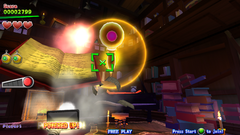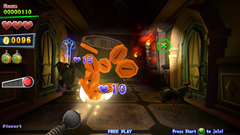Difference between revisions of "Luigi's Mansion Arcade"
From Sega Retro
(screenshots get) |
|||
| Line 19: | Line 19: | ||
==Gameplay== | ==Gameplay== | ||
| + | [[File:LuigisMansionArcade Nu StageSelect.png|thumb|right|200px|Stage Select.]] | ||
''Luigi's Mansion Arcade'' is a mix of a light gun game and ''Luigi's Mansion'' mechanics, and can be played alone or co-operatively with two players (with the second player controlling a Luigi with inverted colours). Players cannot move around on their own, and are instead led through areas automatically, encountering groups of ghosts along the way. | ''Luigi's Mansion Arcade'' is a mix of a light gun game and ''Luigi's Mansion'' mechanics, and can be played alone or co-operatively with two players (with the second player controlling a Luigi with inverted colours). Players cannot move around on their own, and are instead led through areas automatically, encountering groups of ghosts along the way. | ||
Revision as of 13:18, 23 July 2024
| |||||||||||||
| Luigi's Mansion Arcade | |||||||||||||
|---|---|---|---|---|---|---|---|---|---|---|---|---|---|
| System(s): Nu | |||||||||||||
| Publisher: Capcom (JP), Sega (US, EU) | |||||||||||||
| Developer: Capcom | |||||||||||||
| Licensor: Nintendo | |||||||||||||
| Genre: First-person rail shooter | |||||||||||||
| Number of players: 1-2 | |||||||||||||
| Official in-game languages: | |||||||||||||
|
Luigi's Mansion Arcade, known as Luigi Mansion Arcade (ルイージマンション アーケード) in Japan, is an arcade game based on the Nintendo 3DS game Luigi's Mansion: Dark Moon. It was produced by Capcom for Sega's Nu system, and was released outside of Japan by Sega.
Contents
Gameplay
Luigi's Mansion Arcade is a mix of a light gun game and Luigi's Mansion mechanics, and can be played alone or co-operatively with two players (with the second player controlling a Luigi with inverted colours). Players cannot move around on their own, and are instead led through areas automatically, encountering groups of ghosts along the way.
The controllers used by players are designed like the Poltergust 5000 and feature two buttons on the nozzle - the top button operates the Strobulb, which is a flash of light charged by holding down the button then fired by releasing the button, which is used to stun ghosts or to open safes and treasure chests. This button also activates the Dark-Light Device to make invisible objects visible in certain points where it's needed. When a ghost has been stunned, a player can then hold the bottom trigger to begin sucking them up with the vacuum. The vacuum can also be used to suck in treasure as well as other objects and creatures.
When sucking up ghosts, a player must aim the Poltergust 5000 in the opposite direction of where the ghost is fleeing to suck them up for longer and deplete more of their HP, and the ghost will be successfully caught once their HP reaches zero. To help with sucking up ghosts, players can build up a Power Gauge by sucking ghosts for long enough, allowing them to activate a Power Surge that deals heavy damage to the ghost(s) being sucked up by pressing the Strobulb button. Players can also press the green START button on the cabinet to throw a Strobomb, which will simultaneously stun all ghosts in the vicinity. Successfully sucking up ghosts will build a combo counter that will further boost score and coins earned, however the combo will be lost if a player goes for too long without sucking up another ghost.
Players have a limited number of hearts as health, which can be refilled by finding hidden hearts or finishing stages with lots of coins. When all hearts have been depleted, a player must use a credit to continue. When a continue is used, the player is given a Continue Boost, which refills all hearts, temporarily powers up the vacuum and Strobulb flash range, and fully restocks the player's Strobombs. In a 2-player game, the Continue Boost will also support the other player by refilling one of their hearts and giving them one extra Strobomb.
When starting a new game, some cabinets may give players the option of using "Simple Controls", which binds all actions involving the Strobulb button to the vacuum trigger, making them automatically activate in situations where they're needed. For an additional challenge, players are also given the option to start a game in Challenge Mode, which increases the difficulty of the stages as well as reducing the players' maximum health to one heart regardless of the cabinet's life setting.
Stages
All three of the stages in Luigi's Mansion Arcade are based off some of the locations visited in Luigi's Mansion: Dark Moon. Upon starting a new game, only the first two stages are available to start from. Each stage also has a Golden Bone that will affect the ending when all of them have been found.
| Gloomy Manor | |
|---|---|
|
Difficulty (Normal Mode): Easy Difficulty (Challenge Mode): Hard | |
| This stage is recommended for beginners by the game when selecting a stage. At a certain point, the stage path splits in two, and the player(s) can choose which path to take. There is also a secret room that can be found in the bedroom using the Strobulb.
The boss of this stage is The Brain, whose shield must be broken by either sucking up projectiles thrown at Luigi and spitting them at the shield, or by defeating all of the ghosts he summons. When his health has been lowered long enough, he will turn invisible and must be exposed using the Dark-Light Device. He has a total of 120 HP. | |
| Old Clockworks | |
|
Difficulty (Normal Mode): Normal Difficulty (Challenge Mode): Very Hard | |
| Although this stage follows Gloomy Manor, experienced players can choose to skip straight to this stage when starting a new game. The player(s) will need to chase down a Slammer to enter the factory, and eventually chase after a Gobber.
The boss of this stage is the Three Sisters, a trio of female ghosts. These sisters will protect themselves from the Strobulb with mirrors, and can only be stunned whenever they attack Luigi. Each sister has a different amount of HP, with Sister Herlinda (purple) having 70 HP, Sister Belinda (aqua) having 50 HP, and Sister Lucinda (yellow) having 40 HP. When one sister is left, she will summon two Slammers to distract Luigi. | |
| Treacherous Mansion | |
|
Difficulty (Normal Mode): Hard Difficulty (Challenge Mode): Extremely Hard | |
| Of the three stages in the game, this is the only stage that is not available from the beginning and must be unlocked by completing Old Clockworks. This stage has the fewest areas, consisting of only two corridors full of ghosts before reaching the terrace.
The boss of this stage is King Boo, whose barrier must be destroyed by sucking up ghosts or projectiles before he can be flashed. When his HP is low, he will attempt to trick the player(s) by creating copies of himself, and when his HP is depleted at least twice, he will escape the Poltergust 5000 and carry out more aggressive attacks and duplication, with the second phase involving him splitting in two, and the third phase involving a barrage of projectiles. He has 130 HP for the first phase, 20 HP x2 for the second phase, and 50 HP for the final phase. |
History
The game was location-tested from October 30 to November 3, 2014 in Japan by Capcom.[2][3] In North America, location tests were carried out at participating Dave & Buster's locations, with the game getting an official release in Spring 2017.[4][5]
Repair services were transferred to Sega Logistics Service in April 2019,[6][7] and they ended completely in June 2023.[1]
Versions
Localised names
| Language | Localised Name | English Translation |
|---|---|---|
| English | Luigi's Mansion Arcade | Luigi's Mansion Arcade |
| Japanese | ルイージマンション アーケード | Luigi Mansion Arcade |
Specifications
Dimensions
Photo gallery
External links
References
- ↑ 1.0 1.1 File:20230221 capcom sega.pdf
- ↑ https://gamestalk.net/luigi-mansion-arcade/ (Wayback Machine: 2014-11-04 12:36)
- ↑ https://www.ign.com/articles/2014/11/04/luigis-mansion-arcade-game-tested-in-japan-during-halloween (Wayback Machine: 2014-11-04 14:19)
- ↑ http://www.neoseeker.com/news/27421-luigis-mansion-arcade-is-coming-to-north-america-testing-begins-at-dave-busters/ (Wayback Machine: 2015-10-14 12:57)
- ↑ http://www.mdjonline.com/neighbor_newspapers/north_fulton/dave-buster-s-alpharetta-location-opens-doors-to-offer-fun/article_4dffb972-4094-11e7-9a1e-dfd0930617e5.html (Wayback Machine: 2017-06-10 11:02)
- ↑ https://www.capcom.co.jp/arcade/news/operator/20190306.html (Wayback Machine: 2019-03-14 00:06)
- ↑ File:20190401 CAPCOM SERVICE START.pdf
- ↑ 8.0 8.1 8.2 https://segaarcade.com/games/luigis-mansion-arcade (Wayback Machine: 2024-06-05 02:00)












